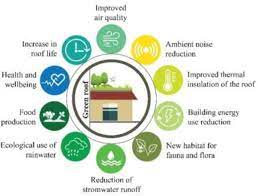I. Introduction
Transforming your roof into a living, green space is not only aesthetically pleasing but also environmentally beneficial. Living roofs, also known as green roofs, provide a range of advantages, from energy efficiency to biodiversity support. In this guide, we’ll explore the benefits of installing a living roof and provide a step-by-step how-to guide for creating your own green oasis atop your home.
II. Benefits of a Living Roof
a. Energy Efficiency
- Natural Insulation: Living roofs act as natural insulators, reducing heat loss in the winter and minimizing heat gain in the summer.
- Cooling Effect: The vegetation on a living roof helps cool the surrounding area, contributing to lower indoor temperatures.
b. Environmental Impact
- Air Quality Improvement: Plants on the roof absorb pollutants and release oxygen, contributing to improved air quality.
- Stormwater Management: Living roofs absorb rainwater, reducing runoff and helping manage stormwater effectively.
c. Biodiversity Support
- Habitat Creation: Living roofs provide habitats for birds, insects, and other wildlife, promoting urban biodiversity.
- Plant Diversity: Choose a variety of plants to attract different species and create a thriving ecosystem.
III. How to Install a Living Roof
a. Structural Assessment
- Consult a Professional: Hire a structural engineer to assess if your roof can support the added weight of a living roof.
- Check Local Regulations: Verify local building codes and regulations regarding green roof installations.
b. Waterproofing and Root Barrier
- Waterproof Membrane Installation: Ensure a waterproof membrane is applied to prevent water leakage.
- Root Barrier Placement: Install a root barrier to protect the roof structure from plant roots penetrating and causing damage.
c. Drainage System
- Install a Drainage Layer: Provide proper drainage by adding a layer of drainage mat or crushed stone.
- Create Outlets: Install drainage outlets to prevent water from pooling on the roof.
d. Growing Medium
- Select the Right Soil Mix: Choose a lightweight, well-draining growing medium suitable for the selected plants.
- Apply Growing Medium: Spread the growing medium evenly across the roof, ensuring an adequate depth for plant roots.
e. Plant Selection
- Choose Native and Hardy Plants: Select plants that are well-suited to your climate and require minimal maintenance.
- Consider Planting Density: Determine the appropriate spacing for plants to allow for optimal growth and coverage.
f. Irrigation System
- Drip Irrigation: Install a drip irrigation system to ensure consistent moisture for the plants.
- Monitor Watering Needs: Regularly monitor soil moisture levels and adjust the irrigation system accordingly.
g. Maintenance Plan
- Weeding: Regularly inspect and remove any weeds to maintain the health of the green roof.
- Pruning: Trim plants as needed to prevent overgrowth and maintain the desired aesthetic.
IV. Conclusion
Installing a living roof is a rewarding endeavor that brings numerous benefits to both your home and the environment. From energy efficiency and improved air quality to creating a biodiverse habitat, the advantages are vast. By following the step-by-step guide and embracing the benefits of a living roof, you not only enhance the visual appeal of your home but also contribute to a more sustainable and eco-friendly living space.
FAQs
- Q: Can any roof support a living roof installation?
- A: Not necessarily. Consult a structural engineer to assess your roof’s capacity and ensure it meets the necessary requirements.
- Q: Are living roofs suitable for all climates?
- A: Yes, living roofs can be adapted to various climates. Choose plants that thrive in your specific climate conditions for optimal success.
- Q: How much weight does a living roof add to a structure?
- A: The weight of a living roof varies depending on factors like the plant selection, growing medium, and irrigation system. A structural engineer can provide a precise assessment.
- Q: Can I install a living roof on an existing structure?
- A: It’s possible, but the structural integrity of the existing roof must be assessed, and modifications may be needed to support the added weight.
- Q: How often do I need to water the plants on a living roof?
- A: The frequency of watering depends on factors such as climate, plant selection, and the growing medium. Regular monitoring is essential to meet the plants’ water needs.

